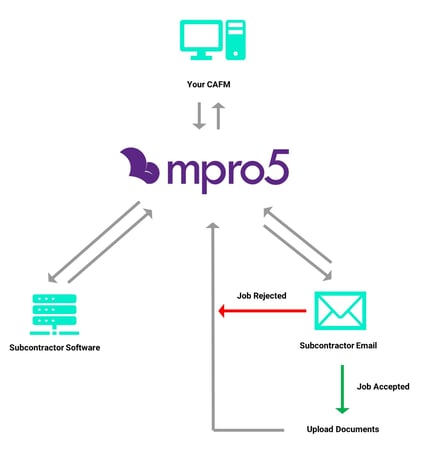NHS National Standards of Healthcare Cleanliness Explained
Many believed it wouldn’t happen in their lifetime but the new National Standards of Healthcare Cleanlinessare finally here - and only nine years...
3 min read
 Konnor Baskaran
Nov 4, 2024 5:54:12 PM
Konnor Baskaran
Nov 4, 2024 5:54:12 PM
If there’s one thing trickier than managing employees, it’s managing subcontractors. It’s a familiar problem for facilities managers who have to rely heavily on an army of specialists, engineers and maintenance teams to manage their buildings and keep them safe and operational.
It may seem that there isn’t any elegant solution to this problem – you’ve got to provide training, check job progress, sort out payments, make sure work is evaluated, keep track of bookings – it’s a ton of admin and then more skilled work on top of that.
It probably means you have a crowded help desk connecting your own CAFM (Computer Aided Facilities Management) to your subcontractors.
Ideally, you want your employees to spend their time doing things that computers can’t – assessing work, evaluating value for money, providing training or planning, not chasing jobs and sending reminders.
The challenge is seamlessly bridging the gap between your own system and your third-parties, who may also have their own widely differing ways of working. It’s like finding a pair of one-size-fits-all boots that are also good for running in, and are a pair of clogs.
But much like superglue – the right software can stick your system to any other, giving you consistent data and working for every sub-contractor you use.
You won’t need nearly as many people from your estates wasting time holding it all together and they can focus on the really important tasks on your estates.
This kind of software is known as ‘middleware’. It bridges the gaps between applications, tools, and databases to provide services to users. It can also be used to link newer applications to older legacy systems.
Middleware will plug into your CAFM system, via an open API or any number of perfectly acceptable lower tech (and cost) alternatives. It works by pulling out all the job data and selecting only the relevant information that will allow a subcontractor to pick up that job and pull it into their own system. The software can see when the subcontractor has booked a job in and pull back this info to update your version of the job, without an endless stream of emails than need to be manually handled.

At this point, you may be wondering if your organization is really large enough for such a solution, or if it’s too big to pick anything other than a proprietary system. If you’re a modest high street dental practice allocating around ten jobs a week to subcontractors, save your money: a simple spreadsheet will suffice.
But once the spreadsheet stops being enough, it’s time to start looking for a solution that’s scalable – both in terms of cost and scope. Whether you’re a forward thinking NHS department, looking for a system wide solution, or a massive supermarket handing out 35,000 jobs a day, the solution is the same: find a configurable platform.
A configurable and scalable software option can be far more budget friendly than a large custom-built solution, and still with a look and feel designed for you.
You simply don’t need software that’s entirely built from the ground up for your operation: it sounds good on paper, but this is usually costly, inflexible and difficult to adapt to changing circumstances. Flexibility, scalability and integration should be your criteria.
%20(1)-jpeg.jpeg?width=300&name=AdobeStock_127176880%20(1)%20(1)-jpeg.jpeg)
So, how do we know this approach works and what does it look like in practice?
Let’s take a look at our own software (of course) working in Coventry & Warwickshire Partnership Trust (CWPT).
In this case, they are using mpro5 as their work management platform of choice. It automatically hands jobs out to the right sub-contractors, receiving job updates and related paperwork back – without a single integration needed.
They now use mpro5 to efficiently manage all 110 sites.
It automates much of the work that would otherwise have to be done manually, assigning jobs to subcontractors and sending the request by email. These contain all the necessary details and gives them the option of either accepting or declining the job. If the job is declined, it’s automatically returned to the trust to be assigned to someone else. Once accepted, it will then automatically chase for updates for you too.
Now that staff no longer need to spend hours on the phone chasing subcontractors, the trust has been able to reduce the number of people operating the helpdesk from nine down to three. Freeing up 6 people to get on with more productive tasks within the department.
The question is: wouldn’t it be better if your CAFM and the software your subcontractors use could be connected – removing the manual intervention that your systems are meant to eliminate? How about one that can act as both a go between and a holistic works management platform for those subcontractors who don’t have any system in place?
If you’re spending a disproportionate amount of time managing your subcontractors, why not let the computer take some of the strain? You don’t need to throw budget at a bespoke solution, just find configurable platform that can grow with you – because middleware might be the super glue to your operations.
Visit our Facilities Management Page for more content
Many believed it wouldn’t happen in their lifetime but the new National Standards of Healthcare Cleanlinessare finally here - and only nine years...
Estates teams face a quandary with NHS assets. Manage them well and you’ll release a much-needed windfall, squander them and you’ll always be short...
Technical compliance with a Planned Preventive Maintenance (PPM) schedule should not be complex to achieve. After all, there are clear instructions...